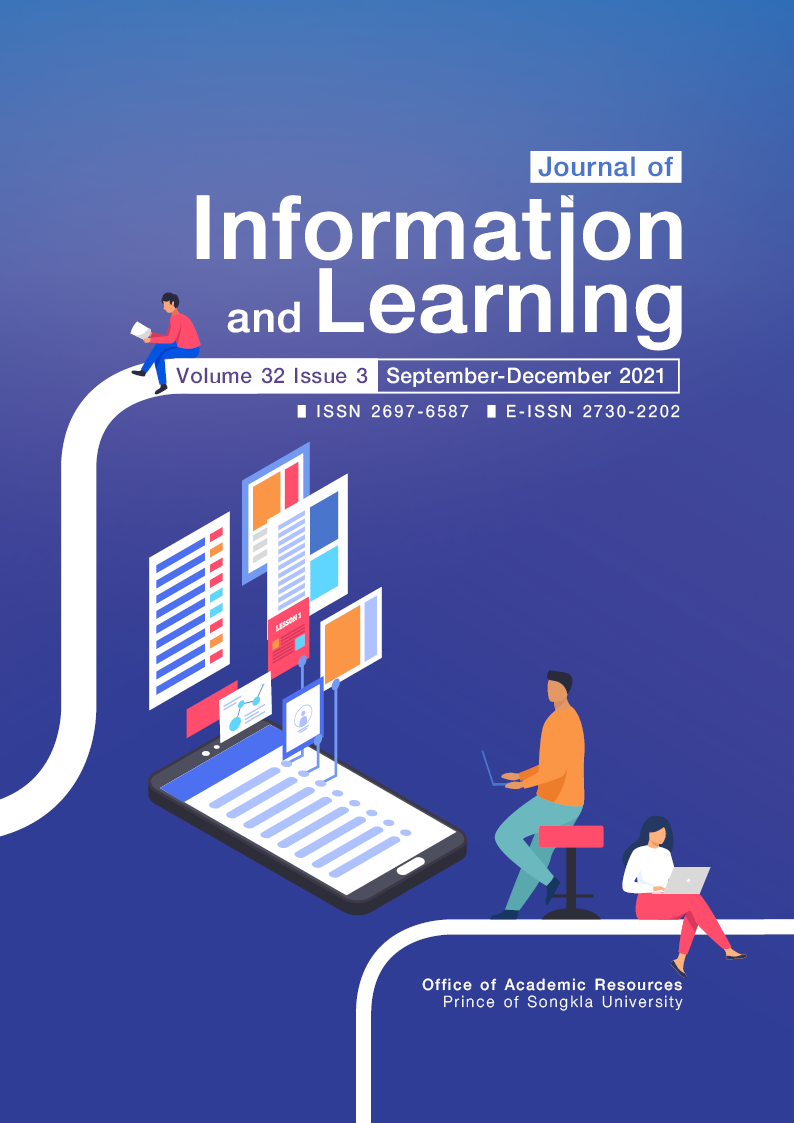Effectiveness of the Application of Design Thinking and Interprofessional Education Approach on the 4Cs of Learning Skills and Interprofessional Collaborative Competencies in Nursing Innovation Course
Main Article Content
Abstract
The purpose of this study was to evaluate the effectiveness of the application of design thinking and interprofessional education approach on the 4 Cs of learning skills and interprofessional collaborative competencies in nursing innovation course. The quasi-experimental with one group pretest-posttest design was conducted. The participants were 188 third-year nursing students. 4Cs and the Interprofessional Collaborative Competency Attainment Survey (ICCAS) questionnaires were employed. Cronbach's alpha reliability coefficients for 4Cs and ICCAS questionnaires were 0.82 and 0.79, respectively. The questionnaires were implemented at pre and post-intervention. Descriptive statistics and paired t-test were used for data analysis.
The results revealed that thirty-eight innovations were produced. After taking this course, the total score of interprofessional collaborative competencies and learning skills (4Cs) significantly increased (p < 0.001). The most improved learning skill was creativity and innovation (t=6.69,p<.001), followed by critical thinking and problem solving (t=4.11, p<.001), communication (t=3.81, p<.001), and collaboration (t=3.20, p<.01), respectively.
In conclusion, the application of design thinking and transprofessional education can develop the 4Cs of 21st-century learning and interprofessional collaboration competencies. Therefore, medical and public health institutions should adopt this concept in conducting innovation courses and others.
The results revealed that thirty-eight innovations were produced. The total score of interprofessional collaborative competencies and learning skills (4Cs) significantly increased (p < 0.001) after invention. The most improved learning skills was creativity and innovation (t=6.69,p<.001) , following by critical thinking and problem solving (t=4.11, p<.001), communications(t=3.81, p<.001), and collaboration(t=3.20, p<.01), respectively.
In conclusion, the application of design thinking and transprofessional education can develop the four key skills (4Cs) of 21st-century learning and interprofessional collaboration competencies. Therefore, medical and public health educational institutions should adopt this concept in innovation and other subjects.
Article Details

This work is licensed under a Creative Commons Attribution-NonCommercial-NoDerivatives 4.0 International License.
The Journal of Information and Learning is operated by the Office of Academic Resources, Prince of Songkla University. All articles published in the journal are protected by Thailand copyright law. This copyright covers the exclusive rights to share, reproduce and distribute the article, including in electronic forms, reprints, translations, photographic reproductions, or similar. Authors own copyrights in the works they have created as well as the Office of Academic Resources. The Journal reserves the right to edit the language of papers accepted for publication for clarity and correctness, as well as to make formal changes to ensure compliance with the journal's guidelines. All authors must take public responsibility for the content of their paper.
References
Archibald, D., Trumpower, D., & MacDonald, C. J. (2014). Validation of the interprofessional collaborative competency attainment survey (ICCAS). Journal of Interprofessional Care, 28(6), 553-558. doi: 10.3109/13561820.2014.917407
Carroll, N., Richardson, I., Moloney, M., & O'Reilly, P. (2017). Bridging healthcare education and technology solution development through experiential innovation. Health and Technology, 8, 255-261. doi: 10.1007/s12553-017-0209-z
Chiruguru, S. B. (2020). The essential skills of 21st century classroom (4Cs). Retrieved from https://www.researchgate.net/publication/340066140_The_Essential_Skills_of_21st_Century_Classroom_4Cs
Dow, A. W., Zhu, X., Sewell, D., Banas, C. A., Mishra, V., & Tu, S. P. (2017). Teamwork on the rocks: Rethinking interprofessional practice as networking. J Interprof Care, 31(6), 677-678. doi:10.1080/13561820.2017.1344048
Ganjitsuda, K., Tagawa, M., Saiki, T., Kikukawa, M., Takamura, A., Okazaki, H., ... & Tomihara, K. (2020). Transprofessional clinical practice improves medical students’ attitudes towards team collaboration. Research Square. doi: 10.21203/rs.3.rs-44279/v1
Gilbert, J. H. V., Yan, J., & Hoffman, S. J. (2010). A WHO report: Framework for action on professional education and collaborative practice. Journal of Allied Health, 39(3, Pt2), 196-197.
Goto, R., & Haruta, J. (2020). The process of interprofessional collaboration: How caregivers integrated the perspectives of rehabilitation through working with a physical therapist. Family Medicine and Community Health, 8(4), e000378. doi:10.1136/fmch-2020-000378
Haruta, J., Kitamura, K., & Nishigori, H. (2017). How do healthcare professionals and lay people learn interactively? A case of transprofessional education. The Asia Pacific Scholar, 2(3), 1-7.
Israsena, P., & Treeratanaphan, C. (2018). Design thinking learning by doing. Bangkok: TCDC.
Ohta, R., Ryu, Y., & Otani, J. (2020). Rural physicians' perceptions about the challenges of participating in interprofessional collaboration: Insights from a focus group study. Journal of Interprofessional Education & Practice, 20, 1-11.
Reeves, S., Lewin, S., Espin, S., & Zwarenstein, M. (2010). Interprofessional teamwork in health and social care. Retrieved from https://www.researchgate.net/publication/273794153_Interprofessional_Teamwork_in_Health_and_Social_Care
Songmuang, J., & Tohtayong, A. (2021). Guidelines for the application of design thinking approachto the change of educational institutions. Journal of Information and Learning, 32(1), 52-57.
Tanglakmankhong, K., Khammathit, A., Thammawongsa, N., & Ardpara, A. (2019). The effectiveness of the nursing innovation course, Using interprofessional education approach on readiness for interprofessional skill and the 21st century skill. The southern College Network Jouranl of Nursing and Public Health, 6(2), 126-139.
Thanormchayathawat, B., Vanitsuppavong, P., Niemted, W., & Portjanatanti, N. (2016). 21st century skills: A challenge for student development. The Southern College Network Journal of Nursing and Public Health, 3(2), 208-222.
Turner, K., Leungratanamart, L., Niranrat, S., Jarnarerux, J., Wattanakul, B., & Reunreang, T. (2015). Twenty first century skills of nursing students of Boromarajonani College of Nursing, Chonburi. Nursing Journal of The Ministry of Public Health, 25(2), 178-193.
Worasuk, N., Piyapadundkit, S., & Siripipattanakul, S. (2020). Effectiveness of inter-professional education to collaborative competency of inter-professional practice and happiness of undergraduate students. Nursing Journal of the Ministry of Public Health, 30(3), 50-61.


